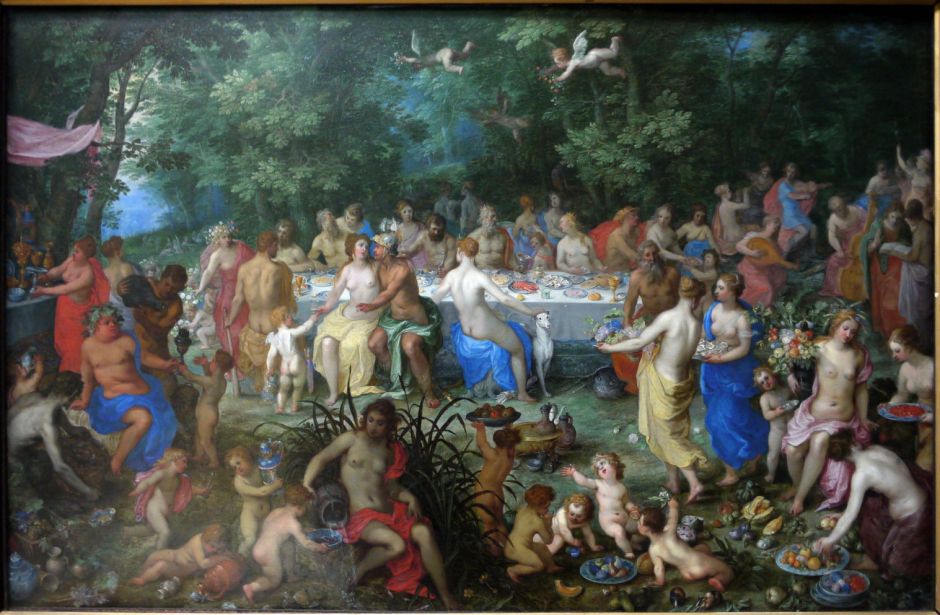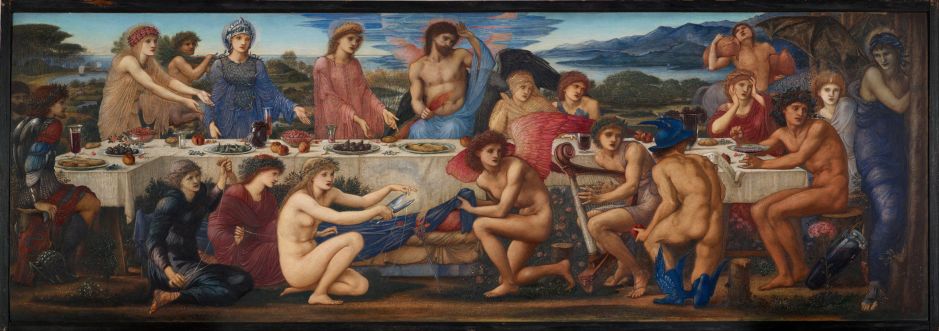After two humorous stories poking fun at King Midas, Ovid makes a start on the central theme for much of the remainder of his Metamorphoses, retelling the myths about Troy, and how its fall led to the foundation of Rome. This account begins with the foundation and fall of the first city of Troy, leading into the birth of Achilles.
The Story
Having won his musical contest against Pan, Apollo then made his way to Laomedon’s kingdom, where he found the king struggling to build the great walls of the first city of Troy. Apollo and Neptune agreed to lend a hand, to make his task more possible. But when the walls were complete, Laomedon denied striking a bargain to repay the gods for their labour. Neptune responded by flooding the city:
And he drove all his waters high upon
the shores of Troy — built there through perfidy.
The sad land seemed a sea: the hard-earned wealth
of all its farmers was destroyed
and overwhelmed by furious waves.
This awful punishment was not enough.
The daughter of the king was soon required
as food for a sea-monster — . Hesione
was chained to rugged rocks. But Hercules
delivered from all harm the royal maid
and justly he demanded of the king,
her father, payment of the promised steeds;
but that perfidious king refused to keep
his promise. Hercules enraged, because
all payment was denied to him for his
great service, captured the twice-perjured walls
of conquered Troy. And as a fair reward,
he gave to Telamon, who fought for him,
Hesione, loved daughter of that king.
For Peleus had a goddess as his bride
and he was prouder of his father-in-law
than of his grandsire. Since not he alone
was grandson of great Jove, but he alone
was honored with a goddess for a wife.
In a scene reminiscent of Andromeda being offered for sacrifice to the sea-monster Cetis, Laomedon’s daughter Hesione was chained to rocks to await her grizzly fate. Rescued by Hercules, Laomedon again welshed on his debt, so Hercules gave Hesione to Telamon.
Ovid’s story then switches to that of Telamon’s brother, Peleus, who married Thetis, one of the fifty Nereid daughters of the ancient sea god Nereus. Thetis had been told by Proteus that her son’s deeds would be famous, and even Jupiter had left her to his grandson Peleus to marry.
Thetis used to visit a remote sea cave, riding up naked astride a dolphin, to sleep. Peleus found her there, and tried to rape her. But she used her powers of transformation to escape his clutches. First she became a bird, then a tree, next a tigress. Peleus pleaded with the sea gods to help him, and Proteus told him to bind her with ropes while she was still asleep.
That he did:
Now Titan was descending and the pole
of his bright chariot as it downward bent
illuminated the Hesperian main;
and at that time the lovely Nereid,
Thetis, departing from her ocean wave,
entered the cavern for desired repose.
Peleus was waiting there. Immediately,
just as he seized upon the virgin’s limbs,
she changed her shape and perservered
until convinced she could not overcome
his hold — for her two arms were forced apart —
she groaned and said, “You could not overcome
me in this way, but some divinity
has given you the power.” Then she appeared
as Thetis: and, when Peleus saw her now
deprived of all deceptions, he embraced
her and was father of the great Achilles.
So Peleus and Thetis were married, and their son was Achilles, soon to prove a central figure in the destiny of the city of Troy.
The Paintings
Ovid’s brief account of these two stories has not been shown very much in paintings.

One of the few works showing the story of Laomedon is thought to have been painted by Joachim von Sandrart and Girolamo Troppa in the late seventeenth century. Its close-cropped figures show Laomedon Refusing Payment to Poseidon and Apollo. The youthful Apollo holds his hand out at the left, while behind him the much older Neptune leans forward next to his trident.

The only painting that I can find of the latter part of the first story is Hans Thoma’s Hercules Delivering Hesione (1890). Hercules stands on the beach in front of the early city of Troy, his trademark club in his right hand. A naked Telamon is busy keeping the sea monster at bay by throwing boulders at it.
Hercules is bargaining with the fair and beautiful Hesione, whom he ultimately gives in marriage to the loyal Telamon as a reward for his services.
There have been some paintings of the rape of Thetis by Peleus, but none was suitable for use here, and all were narratively weak. Far more popular with artists, though, is the wedding of Peleus and Thetis, largely because of its role in the story of the Trojan War according to other, fuller accounts of the myths.
According to those other sources, that wedding was celebrated with a great feast on Mount Pelion, and attended by most of the gods. The happy couple were given many gifts by the gods, but one, Eris the goddess of discord, had not been invited. As an act of spite at her exclusion, she threw a golden apple ‘of discord’ into the middle of the goddesses, to be given as a reward to ‘the fairest’. This set up the Judgement of Paris, and led to the Trojan War.
Paintings of the wedding are lavish, filled with figures, and have a high flesh content. Among my favourites are the following four.

Cornelis van Haarlem’s The Wedding of Peleus and Thetis from 1593 segregates the deities into a separate feast in a sacred grove on the left. There is, as yet, no sign of discord among them, nor of any golden apple. Some of the gods are still among the other guests in the foreground, including Pan (near his pipes, at the left) and Mercury, with his winged hat and caduceus at the right. They seem to be having a good time.

Joachim Wtewael’s undated painting of The Wedding of Peleus and Thetis is great fun, with its aerial band, and numerous glimpses of deities behaving badly. I think that I can also spot Eris, about to sow her apple of discord into their midst: she is in mid-air to the left of centre, the apple held out in her right hand.

Hendrick van Balen and Jan Brueghel the Elder combined their skills to paint The Wedding of Thetis and Peleus together in about 1630. Here it’s the innumerable putti who seem to be running riot, and there is no sign of Eris or her golden apple, as far as I can see.

It is the most modern version, painted by Edward Burne-Jones as The Feast of Peleus in 1872-81, which sticks most closely to the story. In a composition based on classical representations of the Last Supper, he brings Eris in at the far right, her golden apple still concealed. Every head has turned towards her, apart from that of the centaur behind her right wing. Even the three Fates, in the left foreground, have paused momentarily in their work.
Burne-Jones has gone further than simply composing this as a Last Supper, and the figure of Jupiter in the centre, holding a thunderbolt, is overtly Christ-like. I suspect that must have resulted in quite a storm at the time.
Of course, the most famous painting of this event doesn’t show the wedding at all, only the introduction of the golden apple to the feast of the gods.

This is Jacob Jordaens’ The Golden Apple of Discord from 1633, based on a brilliant oil sketch by Rubens. The facially discordant Eris, seen in midair behind the deities, has just made her gift of the golden apple, which is at the centre of the grasping hands, above the table.
At the left, Minerva (Pallas Athene) reaches forward for it. In front of her, Venus, her son Cupid at her knee, points to herself as the goddess most deserving of the apple. On the other side of the table, Juno reaches her hand out for it too. This sets up the Judgement of Paris, and the rest is legendary.
The English translation of Ovid above is taken from Ovid. Metamorphoses. Tr. Brookes More. Boston. Cornhill Publishing Co. 1922, at Perseus. I am very grateful to Perseus at Tufts for this.

